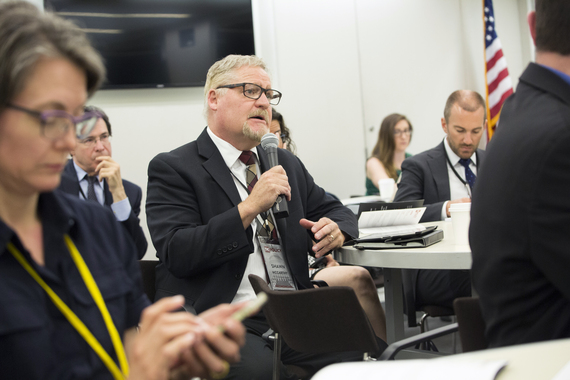
An attendee asks a question at the "How Tech Is Making Government Work Better" session at Techonomy Policy 2015. (Photo by Rebecca Greenfield)
Is tech making government work better? That was the question tackled by an expert panel at the Techonomy Policy conference in Washington in early June. The summary answer: a little bit, but not nearly as much as it could. There's no question technology can make government more effective, deliver more efficient government services to citizens and help officials make better policy decisions. But there are two primary impediments to fulfilling that potential -- bureaucracy (no surprise), and a general fear of the new.
The U.S. government spends in excess of $80 billion annually on technology, and states spend $50 billion more. Yet numerous audits and studies have shown that 20 to 25 percent of this money is being wasted, said panelist Aamer Baig, a senior partner at McKinsey & Co. And citizens appear to realize it. In a McKinsey survey co-led by Baig last year, Americans said they were less satisfied with the federal government than with companies -- even cable companies, the type most notorious for their poor service.. Citizens also say they want government to serve them when and how they want. As all of us are living on our mobile devices and on the Net, and increasingly interacting with companies and other institutions that way, we want the government to serve us that way as well.
"Do we believe that citizens are getting that much value from the investment in technology?" said Baig. "No."
The three panelists who joined moderator Baig on stage have spent the last few years inside various parts of the government attacking the problem of integrating technology into services.
It doesn't seem to be getting easier to make government work smoother digitally. At the Department of Veterans Affairs, the second biggest federal agency, $1 billion has already been spent on a failed effort to exchange electronic healthcare records with the Department of Defense, and $11 billion more is slated for the effort.
"This is something that doesn't work, isn't working today, and has the mandate of the President, three Cabinet secretaries, four deputy secretaries, and me," said Peter Levin, CEO of Amida Technology Solutions and former senior advisor to the VA Secretary and CTO. "This is clearly something that hasn't worked. This is a breakdown of policy, a breakdown of execution, I would argue even insubordination, because we made commitments that weren't achieved."
The VA has had some success giving military veterans better access to their records. The agency's so-called Blue Button effort now allows them to download a full copy of their medical records from one place.
Another panelist was Raphael Majma, a product manager at 18F, a digital services incubator within the General Services Administration. The GSA oversees operational functions in the federal government. The 18F team works to help a variety of federal agencies develop and deliver better digital services. Among projects the incubator is overseeing are openFOIA, a move to improve the online Freedom of Information Act request process and openFEC, which aims to take public data available from the Federal Election Commission and make it easier to use and understand.
The 18F team has also implemented an open-source policy, which requires new projects to open source code from the day that work begins using the popular developers' platform GitHub. The move has drawn comments from people outside the agency, and even outside government, that helped strengthen the resulting software.
"None of this is actually innovative," said Majma, modestly. "Putting stuff out in public and asking for comment is something we've been doing at the Federal Register for forever. The way we do it and the way we interact with citizens is new."
Open data within government isn't simply a buzzword. It's allowing new forms of innovation and information discovery that hasn't been possible before inside government. The Centers for Medicare and Medicaid Services opened its data on the quality of care delivered by healthcare providers to outside companies. Now an application allows consumers to easily access this data and helps them make decisions on doctors according to location. Panelist Damon Davis, director for the Health Data Initiative in the office of the CTO in the Department of Health & Human Services, said this kind of service helps break down cultural barriers within government that restrict access to information.
The panelists agreed that government culture was a key obstacle to making systems more efficient. Majma said there's a lot of fear about making large investments in something new and scrapping an old system. Yet he said he's been able to make progress when he shows he can develop prototypes quickly and safely.
Intertwined with that cultural problem is the fact that many government agencies are struggling with old legacy systems that are difficult to change and update. They were set up to retain data and not share them. The risks that accompany became painfully evident recently when an alleged Chinese group infiltrated the Office of Personnel Management's legacy databases and made off with the records of millions of employees. The files were insecure, with some systems too old to be encrypted. There's also frequently an aversion to exchanging lessons learned across different agencies.
And many of the apparent impediments have roots in a legitimate caution, said Davis: "Don't forget that the government does stuff the way it does for a reason. The government is in the business of protecting us. The reason these regulations are in place is because something bad transpired that caused people to put them in place."
Original article published at Techonomy.com.